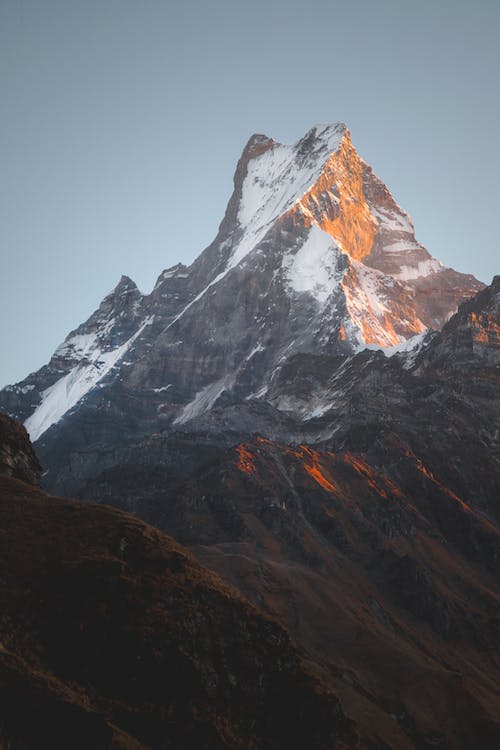Location: Nepal
Elevation: 3, 730 – 5, 550 meters
Dolpo is a Tibetan region located in northern Nepal, well known for the horseshoe shape of its soaring mountains that reach up to 6400 meters. It belongs among the Tibetan plateau that borders the south of China, west of India and Pakistan, and north of Nepal and Bhutan. Even if it is politically a part of Nepal, Dolpo remains culturally tied to Tibet as the region is often cut off to the Nepalis in the south by the intense snow year-round.
The mountain has been home to Tibetan refugees after they suffered deadly attacks from China.
Most Tibetan follow the Tibetan-Buddhist religion as influenced by their neighboring country, India. Geographically, the place is separated by a barrier of the Himalayan mountain chains, deep gorges, and dense forest. The people there live in scattered villages and monasteries across the mountains, making it one of the highest nations on Earth in terms of elevation.
The region first allowed trekking in 1989 and continued to remain untouched with civilizations. Until this day, Dolpo is considered to be the living heritage of the ancient nomadic Tibetan culture. You won’t find any hotel lodges, restaurants, nor attraction passes, thus earning the nickname Ba-Yul or “Hidden Land.”
About the trek
The Dolpo region is a vast plateau with no summit. The trek instead highlights the rich culture of the Tibetans, the panoramic views of the Himalayas, and the side trips to the undiscovered Tibetan lakes and valleys.
There are many treks to choose from. Depending on your desired package, you can choose among those that include the best-selling trips to Phoksundo Lake, Do Tarap Loop, Shey Gompa and Inner Dolpo Lake, and the Upper Mustang.
The terrain will mostly be treeless – a desert-like landscape of gorges and high passes. The road is remote, rugged, and unspoiled, making it the most unforgettable trek in the Himalaya.
When is the best time for the climb
Ideal months to climb are May and June as the snow should be melted off. These months also mark the start of the monsoon. There will be brighter skies, longer daylights, and emerging spring flowers.
How long will the treks take
Phoksundo Lake. This is a relatively short trek that follows the pristine blue waters of the Suli Gaad river at the south of the lake. Phoksundo is the deepest lake in Nepal measuring over 2000 feet deep at a length of 4.8 kilometers and a width of 1.8 kilometers. Completing the trip would take five to six days to and from the Dunai trailhead. There is no accommodation aside from camping. The maximum elevation upon reaching the lake is about 3730 meters. If you still want to go higher, fret not. There are plenty of opportunities to combine Phoksundo Lake trek with others.
Do Tarap Loop. Do Tarap Loop is the most popular trek in the region. Most trekkers approach the route in smaller groups, or in some cases, alone. The trek begins in Thulo Bheri Valley then passes through the remote Tarap Valley, where you will encounter vintage monasteries. You may opt to spend a day or two in the valley before ascending to high passes at Baga La (5170 meters) and Numa La (5290 meters). Not too far from the high passes is the forested shores of Phoksundo Lake. Trekkers may stop at the lake and detour them back to the Juphal airstrip or head further north if they have accompanying permits. Do Tarap Loop is a cheaper option as it avoids pricey area permits in some parts of the mountain. However, the scenery is no less rewarding. The whole duration would take 10-12 days at a 5290-meter elevation.
Shey Gompa and Inner Dolpo. One of the most promoted documented journeys to Shey Gompa is Peter Matthiessen’s 1978 book entitled The Snow Leopard. The award-winning book accounts Matthiessen’s two-month expedition of finding the snow leopard in the Tibetan region. It won the National Book Award both for Contemporary Thought and Non-fiction in 1979-1980.
Permits for upper Dolpo are much costly, but they allow you to traverse across a yak-herding county to the heart of the Tibetan villages. Shey Gompa has the oldest monastery in the region, dating back from the 12th century AD. The routes would take 13-14 days via the Suli Gaad river at the Phoksundo Lake, or 16-18 days via the Do Tarap loop. As you go up, the trail will become more challenging. The maximum elevation for this route is 5160 meters.
Upper Mustang. If a two-week Tibetan plateau trek is not enough, you will surely love the Upper Mustang’s strenuous adventure. This trek is an epic three to four-week course through a striking semi-arid desert with vibrant rock formations and deep ravines. Mustang is a separate district from Dolpo, but its route has become a massive hit to advanced trekkers. Most days are spent at altitudes over 4000 meters after a few stopovers at Dolpo’s best points. High above Shey Gompa is an unforgiving route to Lo-Manthang, the Kingdom of Lo’s walled capital. This kingdom boasts the famous 3-day Tiji Festival held at the beginning of their harvest season (either May or June).
How much does the trek cost
The trek to lower Dolpo (Phoksondo Lake and Do Tarap Loop) ranges from USD 1450 to USD 2325. Upper Dolpo treks, (Shey Gompa and Inner Dolpo and Upper Mustang) costs around USD 3550.

